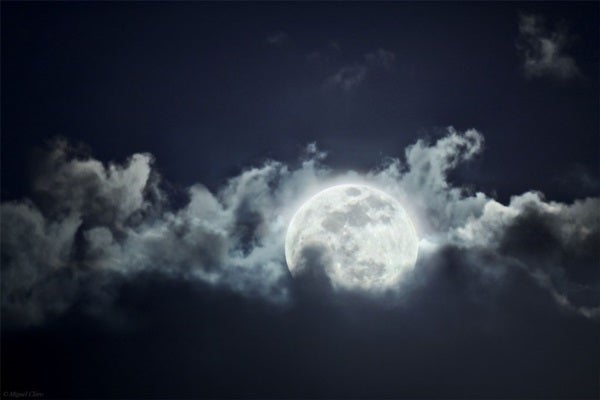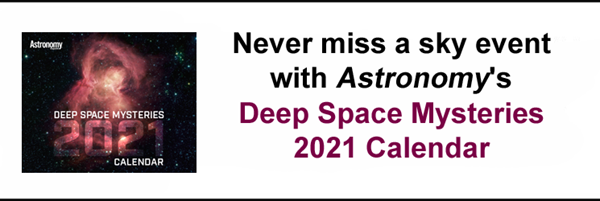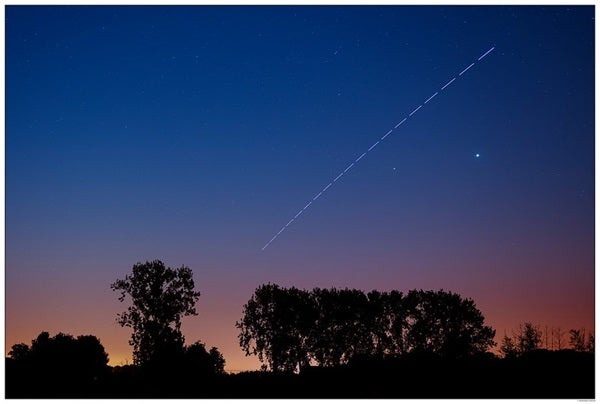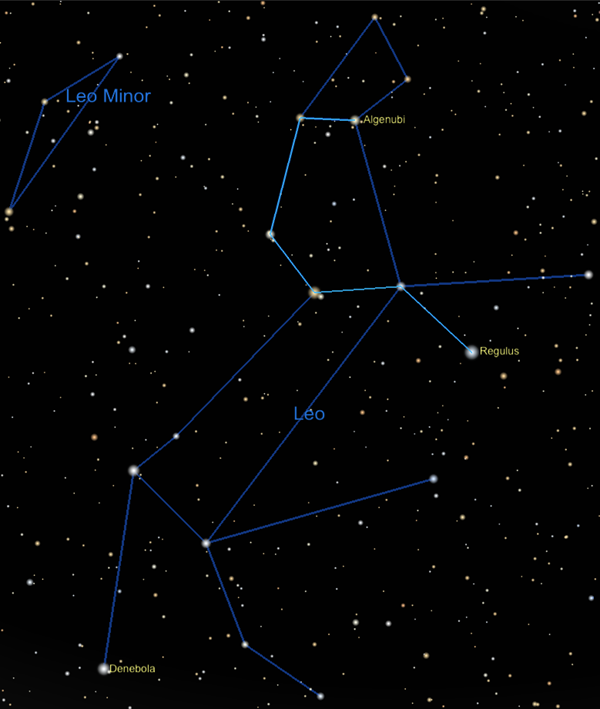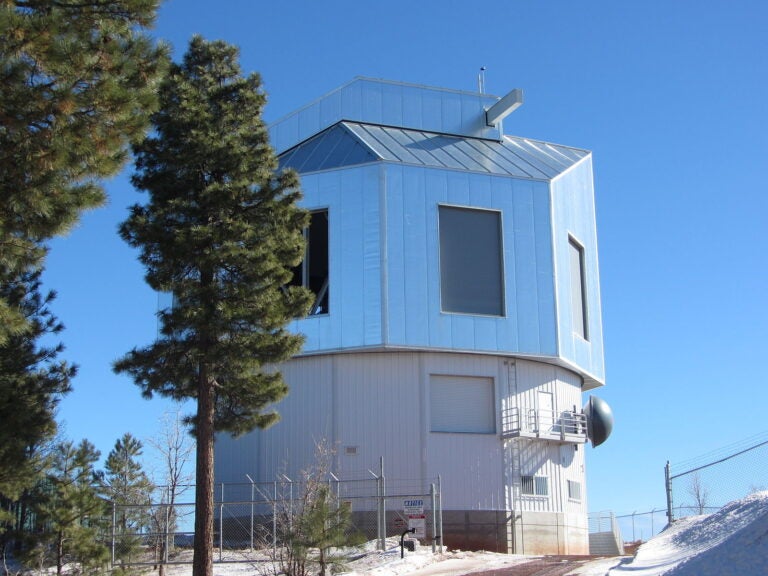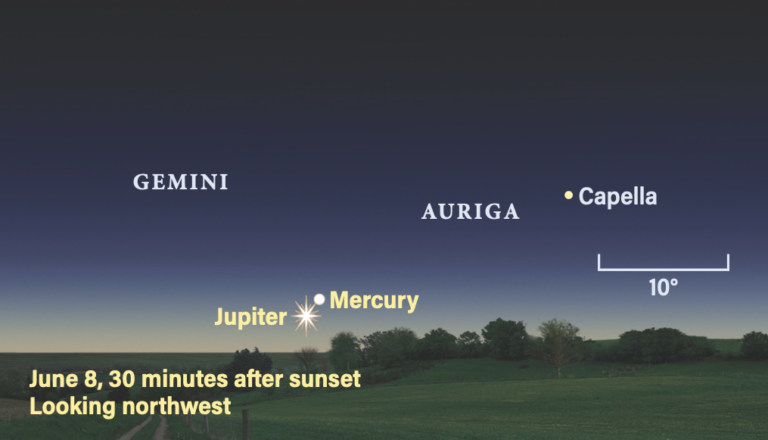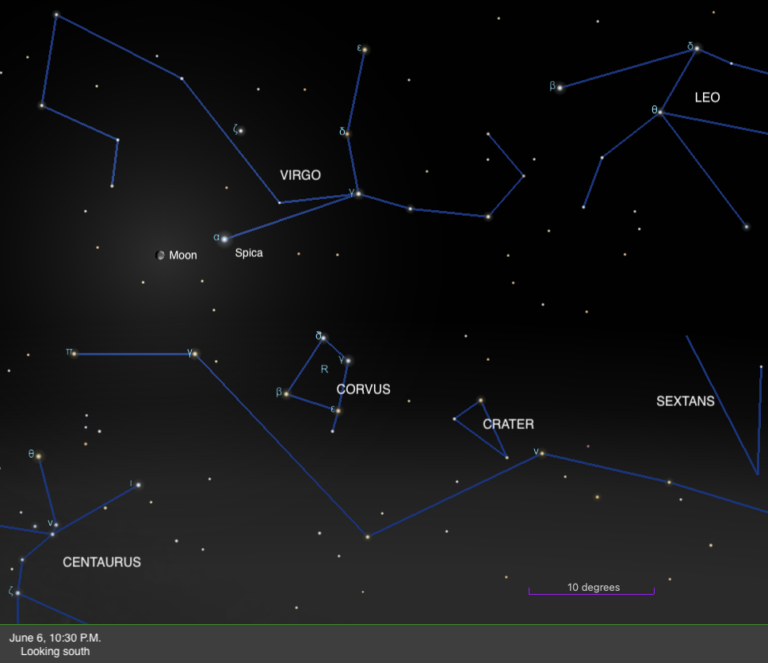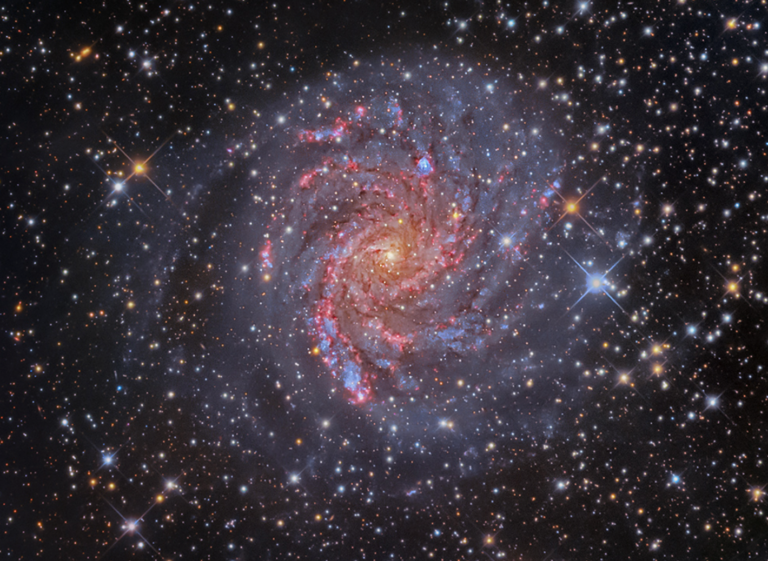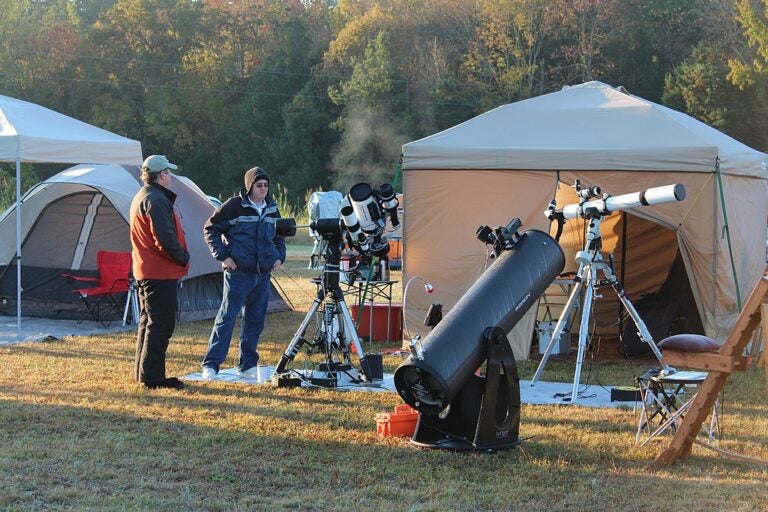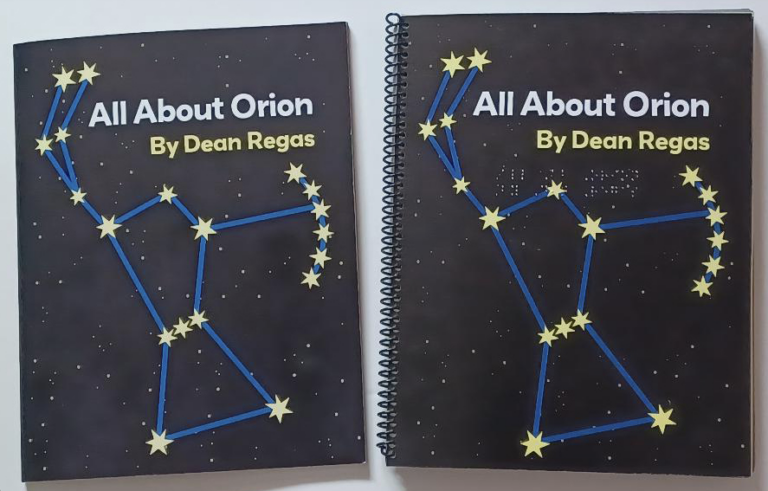The Moon’s orbit around Earth is slightly elliptical, meaning the distance between our planet and its satellite changes regularly. Today the Moon reaches apogee, the farthest point from Earth in its orbit, at 2:45 P.M. EDT. It will then sit 252,522 miles (406,395 kilometers) away.
Nearly Full, the Moon will light up the sky for most of the night. Only brighter stars, planets, and clusters will be easily visible with the naked eye, and even under magnification, many of the finest deep-sky objects will pale in comparison to their appearance under dark, moonless skies.
One cluster you’ll want to seek out is the Wild Duck Cluster (M11) in Scutum. High in the southwest at sunset, this open cluster of young stars formed about 300 million years ago. Its name is derived from the way its brightest stars form a loose v shape on the sky at low power, resembling ducks flying in formation — a sight likely common in the autumn skies for many of our readers. Discovered in 1681 by Gottfried Kirch, the Wild Duck Cluster was later added by Charles Messier to his catalog as one of 26 open clusters in his list. With an apparent magnitude of 6.3, you’ll want to turn binoculars or a small scope on this group of stars, which you’ll find a little less than 2° southeast of Beta (β) Scuti — also called 6 Aquilae. The double name arises from the fact that English astronomer John Flamsteed, whose catalog numbers are still widely used today, ignored the constellation Scutum and instead considered the star part of nearby Aquila.
Sunrise*: 7:28 A.M.
Sunset: 5:59 P.M.
Moonrise: 5:55 P.M.
Moonset: 6:21 A.M.
Moon Phase: Waxing gibbous (99%)
*Times for sunrise, sunset, moonrise, and moonset are given in local time from 40° N 90° W. The Moon’s illumination is given at 12 P.M. local time from the same location.
The Moon passes 3° south of Uranus at 9 A.M. EDT. Three hours later, at noon EDT, Uranus reaches opposition. By an hour after sunset, Uranus and the Moon are 6° apart, both rising in the east in the constellation Aries. You’ll find the ice giant due west of the Moon and will need binoculars or a telescope to spot it, given the bright background light produced by our satellite. Glowing at magnitude 5.7, Uranus’ blue-gray disk is just 4″ wide.
Full Moon occurs at 10:49 A.M. EDT, lighting the Halloween skies for the first time in the central and western U.S. since 2001, and the first time around the world since 1944 (thanks to time zones affecting the date on which the Full Moon falls). But this Full Moon is special for another reason — it’s also a Blue Moon, meaning it’s the second Full Moon in a single calendar month. October 1 also sported a Full Moon, which was called the Harvest Moon because it was the closest Full Moon to the autumn equinox September 22. That gives the Halloween Full Moon the name Hunter’s Moon, the title of the Full Moon that typically falls in October.
Sunrise: 7:29 A.M.
Sunset: 5:58 P.M.
Moonrise: 6:20 P.M.
Moonset: 7:20 A.M.
Moon Phase: Full
Sunday, November 1
Daylight saving time ends this morning at 2 A.M. in places that observe it, so remember that your clock needs to “fall back” an hour overnight. In addition to the extra hour of sleep, you’ll now be able to begin your evening observing sessions earlier.
Asteroid 8 Flora reaches opposition at 2 A.M. EST. The magnitude 8 asteroid is located a mere 25′ west of Gamma (gamma;) Ceti this morning, although it may be a bit difficult to spot with the waning gibbous Moon nearby.
There’s another asteroid skimming through the celestial whale: 471 Papagena is farther south, located 4.25° south-southeast of Mira (Omicron [ο] Ceti). Papagena is a dimmer magnitude 9.5 and is moving slowly, sticking close to Mira all month as it curves west of the star. A small refractor (2.4 inches or larger) should show it, especially with a relatively large field of view (aim for about 1° across, or twice the size of the Full Moon).
If you have trouble spotting either asteroid, simply wait a few days and try again once the bright Moon has moved on.
Sunrise: 6:30 A.M.
Sunset: 4:57 P.M.
Moonrise: 5:47 P.M.
Moonset: 7:18 A.M.
Moon Phase: Waning gibbous (99%)
Today marks the 20th anniversary of the arrival of the first crew — NASA astronaut Bill Shepherd and Russian cosmonauts Yuri Gidzenko and Sergei Krikalev — aboard the International Space Station (ISS). It also marks 20 years of continuous human occupation of the space station.
The ISS, which orbits Earth at a speed of about 5 miles (8 km) per second, takes about 90 minutes to complete one orbit around our planet. It makes 16 orbits each day and is visible from many locations on the ground as sunlight reflects off its surface. To observers on the ground, the ISS looks like a bright, moving star or airplane with no blinking lights.
NASA maintains a website with ISS viewing opportunities by location, which you can use to check the next time you’ll be able to spot the space station overhead. Because the ISS is moving so fast, it takes only moments to pass overhead. You’ll want to get into position early to ensure you have time to find and follow it through the sky.
Sunrise: 6:31 A.M.
Sunset: 4:56 P.M.
Moonrise: 6:19 P.M.
Moonset: 8:18 A.M.
Moon Phase: Waning gibbous (96%)
Tuesday, November 3
Mercury is stationary at 3 A.M. EST; the solar system’s speediest planet is also on its way toward greatest western elongation on the 10th. The planet stands 3° high in Virgo an hour before sunrise, glowing a bright magnitude 0.7 and rivaling nearby Spica (Alpha [α] Virginis), located just 4° west-southwest of the planet. Through a telescope, Mercury appears 25 percent lit and spans 8″; for those interested in coming back day after day, you’ll see it grow to 50 percent lit by November 8, while it shrinks by 1″ during that same timeframe.
Higher above the horizon, hovering between Porrima and Zaniah (Gamma [γ] and Eta [η] Virginis), is Venus. It’s a much brighter magnitude –4, showing an 82-percent-lit crescent that’s 13″ across through a telescope. Venus is moving about 1° along the ecliptic each morning and by November 5, it will sit a mere 1° southwest of Porrima.
Sunrise: 6:32 A.M.
Sunset: 4:55 P.M.
Moonrise: 6:57 P.M.
Moonset: 9:19 A.M.
Moon Phase: Waning gibbous (91%)
Wednesday, November 4
With the end of daylight saving time two days ago, the Sun sets an hour earlier and you can set up to start viewing Jupiter and Saturn even earlier in the evening sky. At sunset, the pair is roughly 30° high in Sagittarius to the south, with only 4.5° separating them. The two giant planets will continue to close in for much of the rest of the year. Saturn shines at magnitude 0.6 and sits northeast of magnitude –2.2 Jupiter.
All four of Jupiter’s Galilean moons stretch out to the planet’s west tonight. In order of appearance from closest to farthest, they are Ganymede, Io, Europa, and Callisto. Although Io orbits physically closest to Jupiter, Ganymede appears nearer to the disk tonight due to projection effects. Don’t be fooled by the 10th-magnitude field star just northwest of Jupiter — the moons all stretch out in a straight line due west of the planet, thanks to the low inclination of Jupiter’s equator to the plane of the solar system along which we view it.
After full darkness has fallen, swing your scope next to a spot 1.25° east-southeast of Jupiter to see if you can find magnitude 14 Pluto — photographers should be able to nab it with a one-minute exposure even through a small refractor.
Sunrise: 6:33 A.M.
Sunset: 4:53 P.M.
Moonrise: 7:41 P.M.
Moonset: 10:17 A.M.
Moon Phase: Waning gibbous (85%)
Thursday, November 5
Return with your telescope to Sagittarius tonight after sunset to catch Comet 88P/Howell nearly due north of Tau (τ) Sagittarii, a 3rd-magnitude star about 3° southeast of brighter magnitude 2 Nunki. Howell floats just over 1° north of Tau, headed for a midmonth rendezvous with Jupiter and Saturn.
Return to Nunki and then drop your scope’s gaze 4° south of the star to spot M54, a magnitude 8 globular cluster. But this is no ordinary globular cluster — it doesn’t belong to the Milky Way, but is instead associated with one of its satellite galaxies, the Sagittarius Dwarf Elliptical Galaxy. When Messier cataloged the cluster in 1778, he had no idea it belonged to a galaxy outside our own. And in fact, the Sagittarius Dwarf wasn’t discovered until just over 200 years later, in 1994.
Sunrise: 6:34 A.M.
Sunset: 4:52 P.M.
Moonrise: 8:32 P.M.
Moonset: 11:13 A.M.
Moon Phase: Waning gibbous (78%)
The Leonid meteor shower begins ramping up tonight, although it won’t come to a peak until November 17. Still, swing your gaze to Leo the Lion this morning as his tail, the bright star Denebola, just clears the horizon around 2 A.M. local time. About 35° due east (upper right) of Denebola is Alpha (α) Leonis, also known as Regulus. This bright star is the base of Leo’s six-star Sickle asterism, which forms the Lion’s regal head and looks like a backwards question mark on the sky. Algenubi, which caps the sickle on its rounded end, can be imagined as Leo’s nose.
The Leonids’ radiant is about 10° due north of Regulus, and you should begin to notice more meteors originating in this region of the sky over the next two weeks. The best time to look for meteors is in the early morning, as the radiant rises higher in the sky but twilight has not yet begun to leach away the darkness.
Sunrise: 6:35 A.M.
Sunset: 4:51 P.M.
Moonrise: 9:30 P.M.
Moonset: 12:03 P.M.
Moon Phase: Waning gibbous (69%)

